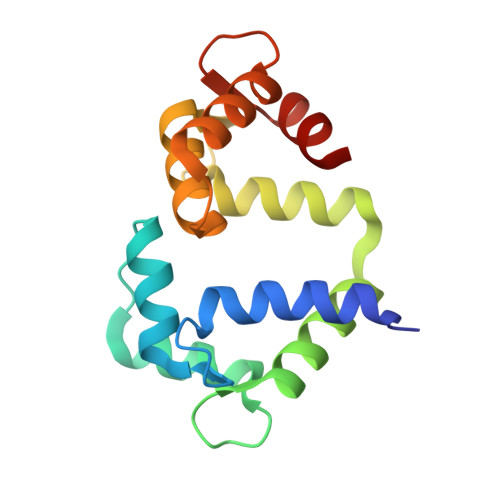Arrhythmia mutations in calmodulin cause conformational changes that affect interactions with the cardiac voltage-gated calcium channel.
Wang, K., Holt, C., Lu, J., Brohus, M., Larsen, K.T., Overgaard, M.T., Wimmer, R., Van Petegem, F.(2018) Proc Natl Acad Sci U S A 115: E10556-E10565
- PubMed: 30348784
- DOI: https://doi.org/10.1073/pnas.1808733115
- Primary Citation of Related Structures:
6DAD, 6DAE, 6DAF, 6DAH, 6GDK, 6GDL - PubMed Abstract:
Calmodulin (CaM) represents one of the most conserved proteins among eukaryotes and is known to bind and modulate more than a 100 targets. Recently, several disease-associated mutations have been identified in the CALM genes that are causative of severe cardiac arrhythmia syndromes. Although several mutations have been shown to affect the function of various cardiac ion channels, direct structural insights into any CaM disease mutation have been lacking. Here we report a crystallographic and NMR investigation of several disease mutant CaMs, linked to long-QT syndrome, in complex with the IQ domain of the cardiac voltage-gated calcium channel (Ca V 1.2). Surprisingly, two mutants (D95V, N97I) cause a major distortion of the C-terminal lobe, resulting in a pathological conformation not reported before. These structural changes result in altered interactions with the Ca V 1.2 IQ domain. Another mutation (N97S) reduces the affinity for Ca 2+ by introducing strain in EF hand 3. A fourth mutant (F141L) shows structural changes in the Ca 2+ -free state that increase the affinity for the IQ domain. These results thus show that different mechanisms underlie the ability of CaM disease mutations to affect Ca 2+ -dependent inactivation of the voltage-gated calcium channel.
- Department of Biochemistry and Molecular Biology, University of British Columbia, Vancouver, BC V6T 1Z3, Canada.
Organizational Affiliation:


















